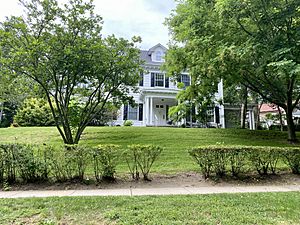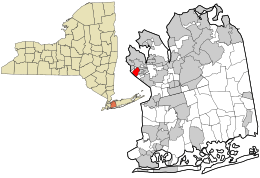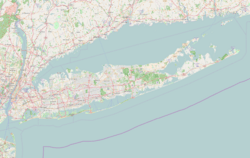Great Neck Estates, New York facts for kids
Quick facts for kids
Great Neck Estates, New York
|
|
|---|---|
| Incorporated Village of Great Neck Estates | |

Great Neck Estates Village Hall on June 11, 2021.
|
|
| Nickname(s):
The Estates; GNE; VGNE
|
|

Location in Nassau County and the state of New York
|
|
| Country | |
| State | |
| County | Nassau |
| Town | North Hempstead |
| Incorporated | 1911 |
| Area | |
| • Total | 0.80 sq mi (2.08 km2) |
| • Land | 0.77 sq mi (1.98 km2) |
| • Water | 0.04 sq mi (0.09 km2) |
| Elevation | 82 ft (25 m) |
| Population
(2020)
|
|
| • Total | 2,990 |
| • Density | 3,903.39/sq mi (1,507.27/km2) |
| Time zone | UTC−5 (Eastern (EST)) |
| • Summer (DST) | UTC−4 (EDT) |
| ZIP code |
11021
|
| Area codes | 516, 363 |
| FIPS code | 36-30191 |
| GNIS feature ID | 0951638 |
Great Neck Estates is a small village located on the Great Neck Peninsula. It is part of the Town of North Hempstead in Nassau County, New York. This village is found on the North Shore of Long Island. In 2020, about 2,990 people lived there.
Contents
History of Great Neck Estates
Great Neck Estates became an official village in 1911. It was the second village on the Great Neck Peninsula to do so. People living there wanted to have more control over their local area. They believed that becoming a village would help them get better services. These services would be hard to get otherwise from the larger Town of North Hempstead.
In 1981, a special plaque was placed at the Village Hall. This plaque celebrated 70 years since Great Neck Estates became a village.
In 1982, Great Neck Estates made history. It was the first village on Long Island to ask for a "nuclear freeze." This meant they wanted the United States and the former Soviet Union to stop making nuclear weapons. Three local residents started a petition, and the village leaders agreed. Copies of their request were sent to the leaders of both countries. This was part of a big effort for peace.
Geography of Great Neck Estates
Great Neck Estates covers a total area of about 0.8 square miles (2.08 square kilometers). Most of this area is land. Only a small part, about 0.04 square miles (0.09 square kilometers), is water.
People Living in Great Neck Estates
| Historical population | |||
|---|---|---|---|
| Census | Pop. | %± | |
| 1920 | 339 | — | |
| 1930 | 1,738 | 412.7% | |
| 1940 | 1,969 | 13.3% | |
| 1950 | 2,464 | 25.1% | |
| 1960 | 3,262 | 32.4% | |
| 1970 | 3,131 | −4.0% | |
| 1980 | 2,936 | −6.2% | |
| 1990 | 2,790 | −5.0% | |
| 2000 | 2,756 | −1.2% | |
| 2010 | 2,761 | 0.2% | |
| 2020 | 2,990 | 8.3% | |
| U.S. Decennial Census | |||
In 2020, the population of Great Neck Estates was 2,990 people. The village has grown quite a bit since 1920, when only 339 people lived there. The population has changed over the years, with some ups and downs.
Education in Great Neck Estates
School District
All of Great Neck Estates is part of the Great Neck Union Free School District. This means that children living in the village go to public schools within this district.
Library District
The village is also part of the Great Neck Library District. This allows residents to use the local library services.
Important Places
- Ben Rebhuhn House – This is a special house designed by a famous architect named Frank Lloyd Wright.
Great Neck Estates and The Great Gatsby
In the 1920s, a famous writer named F. Scott Fitzgerald lived in Great Neck Estates. His house was at 6 Gateway Drive. This is one of the most well-known facts about Great Neck. His home was simple, much like the house of Nick Carraway, a character in his famous novel, The Great Gatsby.
Many people believe that Fitzgerald based the fictional town of West Egg on Great Neck. In the book, West Egg is where Nick and the rich Jay Gatsby live. It was known for its flashy new money style. Fitzgerald is thought to have based East Egg, where Daisy and Tom lived, on Sands Point. Sands Point is a nearby area known for its older, more traditional wealth.
See also
 In Spanish: Great Neck Estates para niños
In Spanish: Great Neck Estates para niños




